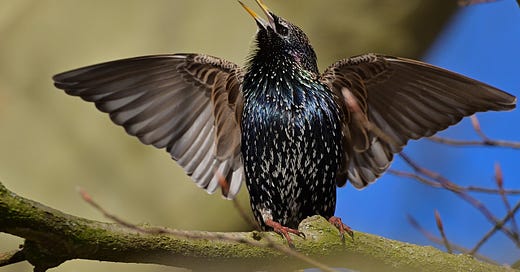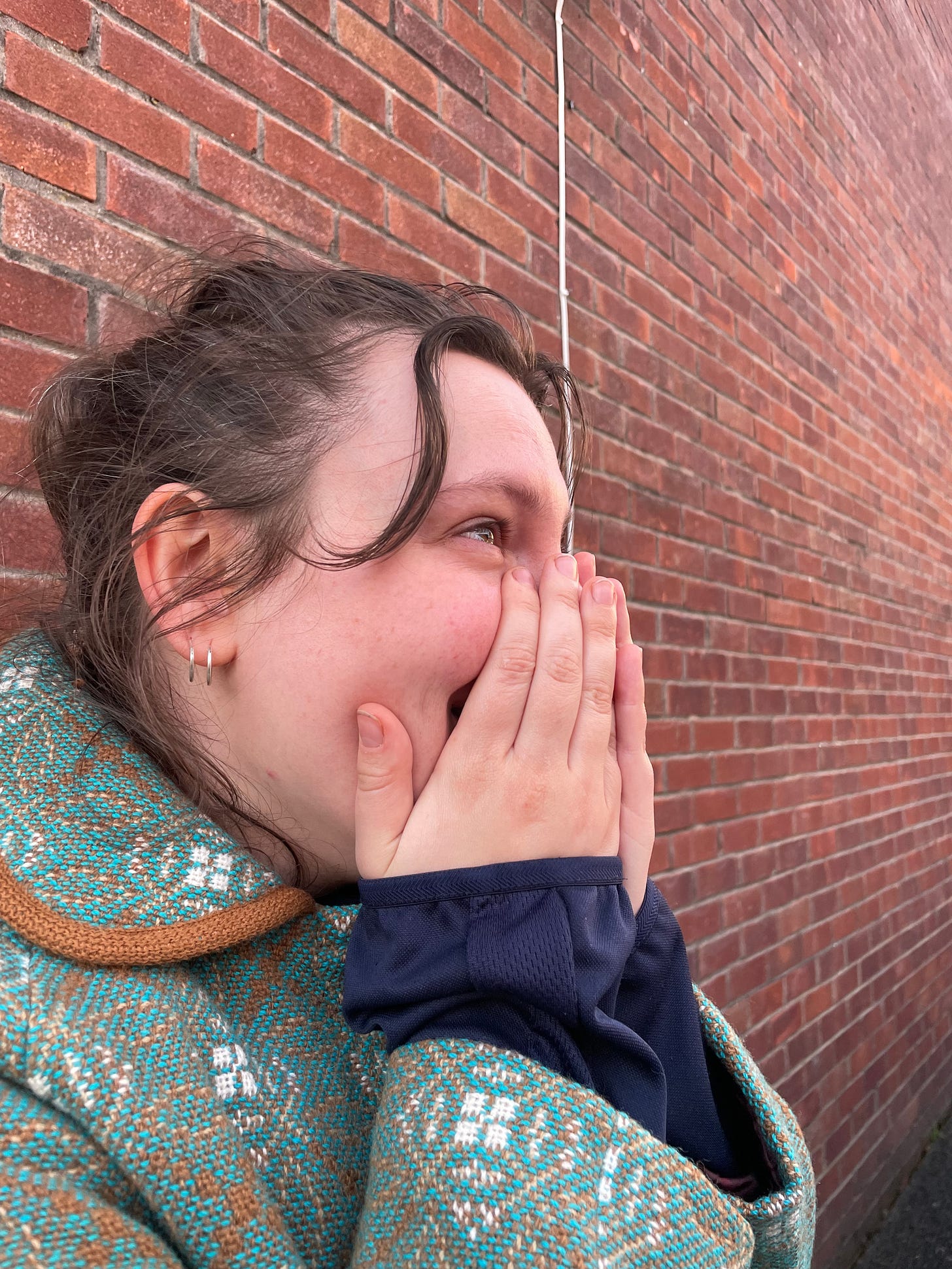Starlings are the best birds and I will die on this hill
In which Hari discusses tiny feathery criminals
Hello, this post is about death and- Wait- Sorry- no, that’s a different Substack. Sorry. This post is about my complex relationship with nature.
No one has ever asked me what my favourite bird is, because obviously everyone lacks culture, but if someone did, I would tell them the starling. All of you who know even 3 things about British ecology will be like ‘Hari, that is literally the worst bird you could pick.’ But I don’t care. Starlings are, for the most part, annoying, over-populated and threaten other forms of native wildlife. They are like pigeons but even worse, because pigeons sad for their lot in life, whereas starlings endlessly look like they are thriving. But I do, I love them. They are my favourite bird. I am currently sat in my back garden, looking at the grey above me, and the husky trees full of cold, bare branches, and I am keenly aware that the starling song is, in fact, one of the only things that makes the endless monochrome of the Welsh winter even vaguely bearable.
The starling’s song is not the only thing that is amazing about them, but it is an incredibly good place to start. Starlings are one of nature’s greatest mimics. I would not be able to tell you what their natural call is - I believe it’s a whistle that lifts up and down in pitch, sort of similar to the noise you would make in your head if you watched a ball get tossed really high in the air and then fall back down. I’m not sure though, because I have had people suggest that that is mimicked from the great tit, but having listened to the ones around us a lot, that is the noise they make most frequently when calling each other. As I say though, you would never know, because these little creatures have more impressions than an episode of Dead Ringers. In the last five minutes alone, I have heard the little group of four above my head take on: a blackbird, the ekekeking of a cat, a car alarm, a door opening and closing, sparrows and a chaffinch. For a long time, when I listened to the birdsong outside my window, I was absolutely convinced that we had remarkable biodiversity in our local area. Once I learned a little more about these hyperactive brown menaces, I realised that that might not actually be the case.
There is a lovely documentary on starlings from the 1960s/1970s that you can access on YouTube, and it gives you a lot of information about these masters of vocal disguise. Almost none of it is positive. As I said, they crowd out almost everything apart from corvids (I’ve actually seen them hanging around in groups of crows and magpies, presumably undercover, but maybe they’re just an honorary member of the gang). They crack the eggs of other birds, throw young-uns out of the nest, and lay their eggs in other birds’ homes for other mothers to raise. They will seemingly, eat anything, from berries and seeds to other smaller birds. Because of their varied diet and hardy nature, they can overwinter in the UK, meaning they can muscle their way into all the best spots before the other native wildlife even open the door and say hello. They can use basic tools, problem solve, and are constantly upping their mimic game to cause the most confusion and chaos possible. They are, in essence, the humans of the bird world. They are the true villains of British wildlife’s story, and they will take no prisoners.
But then you look into the sky on a lucky Tuesday afternoon, and you see a huge murmuration cross below the clouds. You see the sky become a series of complex abstract patterns. You understand that you could not see this in any art gallery. That the world has offered you something in this moment that you cannot put a price on, and that many people will never get a chance to see. And you, because you live here in the UK, get to just, walk home as if nothing has happened, because for you that is just a Tuesday in January.
Contrary to what you may think, starlings rarely ever bump into one another during murmurations. Unlike bats, whose poor eyesight and limited sonar means that there is a good chance they will smack another unwitting batty friend, starlings use their exceptional sensory skills and agility to just - not do that. I’m sure an avian biologist could tell you why, but I don’t need to know why to know they are amazing (although I am googling it as we speak).
My best friend’s favourite bird is the crow, and I get it. I do. They use tools better, they can solve more complex problems. You can basically make a crow your best friend, and they will bring you presents and peck the eyes out of your enemies. But I, personally, have enough human friends. I like my animal world with a side of feral chaos. We don’t have to compare them - the world would be a far worse place without crows and (perhaps also) starlings, but if I’m picking one to watch for the rest of my life, it would be a starling.
I have had Covid for the last week and a half, and so getting outside has been tough (of course it has, I couldn’t possibly announce taking on a massive challenge and then not immediately find a way to fall down at the first hurdle). I could not physically go to nature. But, as I laid in my bed feeling as though my muscles were on fire and my bones were going to dislocate and I was going to drown in my own lymphatic fluids, I could mentally go out and sit in the trees with the little groups of feathery trouble-makers that sit on the branches outside my window. I could listen to them bark at passing dogs and cause chaos by pretending to be a crying baby. I could watch them hide amongst the crows, and make nests in the rooftops.
Here is a picture of the time I saw two starlings making a nest in my neighbours’ roof, and I cried.
There is little to no point to this blog. It does not aid the world in any way. It does not help us understand anything better or alter our perception of reality. It does not make the world a better place. It is what one of my good friends would call ‘literary junk food’. I cannot pretend this was anything other than a chance to write about something that made me smile - I had no intellectual goals in writing it. I hope you enjoyed it anyway.
As I sit here now, I can see the tail feathers of a male starling sticking out from under a roof tile. In their little worlds, childcare is everyone’s responsibility. I occasionally hear him chirrup. He’s been in there for quite a while, with his little bum sticking out in the cold. I hope he’s not stuck. I assume he isn’t, or he would be kicking up much more of a fuss than he is. I don’t know if he is tending to little hatchlings, or he’s just trying to make the place nice for when they finally arrive, but he is present in his world, as I am in mine. What a blessing my favourite birds are.






I have also cried at the starlings nesting in the neighbours roof. Also, I saw a bunch of them using somebody’s clearly blocked gutter as a bird bath yesterday that made me laugh
I am sitting here with a chest infection, much like your Covid, and the starlings outside on my feeders lifted me so and led me to this post! I was in awe today of how well they blend into the Pyracantha, so disguised in their plumage! Thank you!